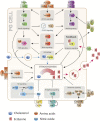Regulation of Body Size and Growth Control
- PMID: 33023929
- PMCID: PMC7536854
- DOI: 10.1534/genetics.120.303095
Regulation of Body Size and Growth Control
Abstract
The control of body and organ growth is essential for the development of adults with proper size and proportions, which is important for survival and reproduction. In animals, adult body size is determined by the rate and duration of juvenile growth, which are influenced by the environment. In nutrient-scarce environments in which more time is needed for growth, the juvenile growth period can be extended by delaying maturation, whereas juvenile development is rapidly completed in nutrient-rich conditions. This flexibility requires the integration of environmental cues with developmental signals that govern internal checkpoints to ensure that maturation does not begin until sufficient tissue growth has occurred to reach a proper adult size. The Target of Rapamycin (TOR) pathway is the primary cell-autonomous nutrient sensor, while circulating hormones such as steroids and insulin-like growth factors are the main systemic regulators of growth and maturation in animals. We discuss recent findings in Drosophila melanogaster showing that cell-autonomous environment and growth-sensing mechanisms, involving TOR and other growth-regulatory pathways, that converge on insulin and steroid relay centers are responsible for adjusting systemic growth, and development, in response to external and internal conditions. In addition to this, proper organ growth is also monitored and coordinated with whole-body growth and the timing of maturation through modulation of steroid signaling. This coordination involves interorgan communication mediated by Drosophila insulin-like peptide 8 in response to tissue growth status. Together, these multiple nutritional and developmental cues feed into neuroendocrine hubs controlling insulin and steroid signaling, serving as checkpoints at which developmental progression toward maturation can be delayed. This review focuses on these mechanisms by which external and internal conditions can modulate developmental growth and ensure proper adult body size, and highlights the conserved architecture of this system, which has made Drosophila a prime model for understanding the coordination of growth and maturation in animals.
Keywords: DILP8; Drosophila; FlyBook; PTTH; checkpoint; critical weight; ecdysone; insulin; metamorphosis; prothoracic gland; timing.
Copyright © 2020 by the Genetics Society of America.
Figures






Similar articles
-
Hypoxia delays steroid-induced developmental maturation in Drosophila by suppressing EGF signaling.PLoS Genet. 2024 Apr 26;20(4):e1011232. doi: 10.1371/journal.pgen.1011232. eCollection 2024 Apr. PLoS Genet. 2024. PMID: 38669270 Free PMC article.
-
Drosophila Lgr3 Couples Organ Growth with Maturation and Ensures Developmental Stability.Curr Biol. 2015 Oct 19;25(20):2723-9. doi: 10.1016/j.cub.2015.09.020. Epub 2015 Oct 1. Curr Biol. 2015. PMID: 26441350
-
Nutrient signaling and developmental timing of maturation.Curr Top Dev Biol. 2013;105:37-67. doi: 10.1016/B978-0-12-396968-2.00002-6. Curr Top Dev Biol. 2013. PMID: 23962838 Review.
-
Snail synchronizes endocycling in a TOR-dependent manner to coordinate entry and escape from endoreplication pausing during the Drosophila critical weight checkpoint.PLoS Biol. 2020 Feb 25;18(2):e3000609. doi: 10.1371/journal.pbio.3000609. eCollection 2020 Feb. PLoS Biol. 2020. PMID: 32097403 Free PMC article.
-
Body size regulation by maturation steroid hormones: a Drosophila perspective.Front Zool. 2018 Nov 20;15:44. doi: 10.1186/s12983-018-0290-9. eCollection 2018. Front Zool. 2018. PMID: 30479644 Free PMC article. Review.
Cited by
-
Serotonergic neuron ribosomal proteins regulate the neuroendocrine control of Drosophila development.PLoS Genet. 2022 Sep 1;18(9):e1010371. doi: 10.1371/journal.pgen.1010371. eCollection 2022 Sep. PLoS Genet. 2022. PMID: 36048889 Free PMC article.
-
The wing imaginal disc.Genetics. 2022 Apr 4;220(4):iyac020. doi: 10.1093/genetics/iyac020. Genetics. 2022. PMID: 35243513 Free PMC article.
-
Roles of herbivorous insects salivary proteins.Heliyon. 2024 Apr 3;10(7):e29201. doi: 10.1016/j.heliyon.2024.e29201. eCollection 2024 Apr 15. Heliyon. 2024. PMID: 38601688 Free PMC article. Review.
-
The Drosophila estrogen-related receptor promotes triglyceride storage within the larval fat body.J Lipid Res. 2025 Jun;66(6):100815. doi: 10.1016/j.jlr.2025.100815. Epub 2025 Apr 25. J Lipid Res. 2025. PMID: 40288680 Free PMC article.
-
Growth phase diets diminish histone acetyltransferase Gcn5 function and shorten lifespan of Drosophila males.EMBO Rep. 2025 Aug;26(15):3856-3888. doi: 10.1038/s44319-025-00503-8. Epub 2025 Jul 10. EMBO Rep. 2025. PMID: 40640422 Free PMC article.
References
Publication types
MeSH terms
LinkOut - more resources
Full Text Sources
Molecular Biology Databases

